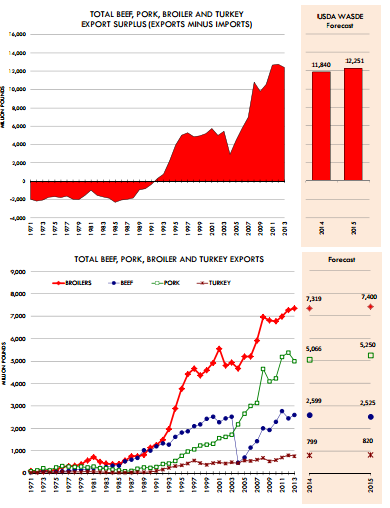



CME: Pork Exports Increased Dramatically
US - Pork exports have increased dramatically since the 1990s and currently account for over 20 per cent of total domestic production, write Steve Meyer and Len Steiner.There has been a lot of discussion in recent years about the correct US stance with regards to agricultural trade.
The implementation of COOL (Country of Origin Labelling) was seen as a victory for those that think the primary focus of US government is to provide domestic producers with advantageous access to US consumers.
The reality of trade flows, however, is that the US is by far a net meat protein exporter. As such, it is in the interest of the US to advocate for a reduction of non-tariff trade barriers.
Current forecasts are for US beef, pork, chicken and poultry production to be a total 91.017 billion pounds in 2014.
Out of this total production number, about 15.783 billion pounds (17 per cent) will go to markets outside of the US.
Imports of beef, pork and poultry are expected to total 3.943 billion pounds. In other words, the US has a 11.840 trade surplus when it comes to meat protein trade. That surplus increased dramatically following the implementation of the General Agreement on Tariffs and Trade (GATT) in 1994.
Free trade agreements with a number of countries also have further supported the growth in US meat protein exports.
Chicken exports account for a large portion of that trade surplus. This is because the US has a significant trade advantage in terms of chicken production.
Lower feed costs, technological advancements and a preference among US consumers for white meat (while other countries prefer dark meat) have provided significant opportunities for US chicken exports.
USDA projects chicken shipments in 2014 to reach 7.319 billion pounds, just slightly below all time record levels established last year (7.345 billion). In the early 1990s, US chicken exports were hovering around one to 1.5 billion pounds.
Today, exports account for about 19 per cent of total US chicken production. US chicken imports are minimal (around 100 million pounds). The top market for US chicken at the moment is Mexico.
Mexican officials have indicated they want to place significant tariffs on US chicken but so far have refrained in doing so because they simply do not have the production capacity to meet domestic demand and fear the impact of rampant meat price inflation.
Russia used to be a top market for the US but US broiler producers have successfully diversified away from that market and recent bans on US chicken have had limited impact.
USDA projects chicken exports in 2015 to reach 7.4 billion pounds, 1.1 per cent higher than in 2014.
Pork exports have also increased dramatically since the 1990s and currently account for over 20 per cent of total domestic production.
Despite significant pork supply shortages this year and wholesale prices that in some cases were 60-70 per cent higher than the previous year (hams, trimmings), US pork exports this year are projected at 5.066 billion pounds, 1.5 per cent higher than a year ago.
Next year, USDA projects pork exports to reach 5.250 billion pounds, a 3.6 per cent increase and accounting for 22 per cent of total US pork output.
Asia and North America remain the primary destinations for US pork although US pork shipments are well diversified, with South America emerging as a significant buyer in the last few years.
As for beef exports, USDA projects 2015 exports to decline 2.8 per cent. Beef is the only protein where the US has a small trade deficit. This year, the projection is for 2.823 billion pounds of beef imports and 2.599 billion pounds of exports.
Next year US beef exports are expected to be down 2.8 per cent and beef imports are expected to decline 4.4 per cent, largely because the pace of imports from Australia is unsustainable.
It is quite telling that US cattle prices this year have established all time record highs even as beef imports have jumped 25.5 per cent.
The path forward for US meat producers is not to try to close doors. Rather, we need to focus on nurturing meat protein demand, both in the domestic and export markets.
History shows that is the only profitable way.









